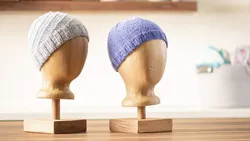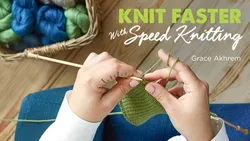
Hat Knitting 101 
Learn how to knit a basic beanie with expert Jen Lucas! In this class, Jen takes you step-by-step through the process of knitting a hat, from the materials needed to the finishing touches. She shares her tips and tricks on how to make your hat knitting as easy as possible. Get ready to create a professional-looking hat with nearly 60 minutes of clear instruction and PDF materials. Join Hat Knitting 101 today! ▼
ADVERTISEMENT
Course Feature
![]() Cost:
Cost:
Paid
![]() Provider:
Provider:
Craftsy
![]() Certificate:
Certificate:
Paid Certification
![]() Language:
Language:
English
![]() Start Date:
Start Date:
On-Demand
Course Overview
❗The content presented here is sourced directly from Craftsy platform. For comprehensive course details, including enrollment information, simply click on the 'Go to class' link on our website.
Updated in [June 30th, 2023]
Hat Knitting 101, taught by knitting expert Jen Lucas, is a comprehensive course that takes students step-by-step through the process of knitting a basic beanie. The course begins with an overview of the materials needed to complete the hat and how to begin the hat using the German Twisted cast-on. Jen then demonstrates how to join and knit in the round, as well as how to make changes to the brim, if desired. She then moves on to the body of the hat and explains how to switch from a circular needle to double-pointed needles to complete the crown. Jen also shares her tips for finishing the hat and how to work interesting stitch patterns into your next hat. With nearly 60 minutes of clear instruction and PDF materials to help you on your hat knitting journey, this course is sure to provide students with the skills and knowledge they need to create beautiful hats.
[Applications]
After taking Hat Knitting 101, students can apply their newfound knowledge to create a variety of hats. They can use the techniques taught in the class to make a basic beanie, or they can experiment with different stitch patterns to create more complex hats. Additionally, they can use the tips and tricks shared by the instructor to make their hats look polished and professional. With the skills learned in this course, students can create hats for themselves, friends, and family.
[Career Path]
One career path recommended to learners of Hat Knitting 101 is that of a Hat Knitting Designer. Hat Knitting Designers are responsible for creating unique and stylish hats for a variety of purposes, such as fashion, sports, and special occasions. They must have a strong understanding of knitting techniques and be able to create hats that are both aesthetically pleasing and comfortable to wear. Hat Knitting Designers must also be able to work with a variety of materials, such as wool, cotton, and synthetic fibers.
The development trend for Hat Knitting Designers is that they are increasingly in demand as the popularity of knitting continues to grow. As more people become interested in knitting, the demand for unique and stylish hats is also increasing. Hat Knitting Designers must stay up to date on the latest trends in knitting and be able to create hats that are both fashionable and comfortable. Additionally, Hat Knitting Designers must be able to work with a variety of materials and be able to create hats that are suitable for a variety of purposes.
[Education Path]
The recommended educational path for learners of Hat Knitting 101 is to pursue a degree in Textile Design. Textile Design is a field of study that focuses on the design, production, and marketing of fabrics and other textiles. It involves the use of a variety of materials, including yarns, fibers, and fabrics, to create unique and functional products. Textile Designers use their knowledge of color, texture, and pattern to create fabrics that are both aesthetically pleasing and functional.
A degree in Textile Design typically requires a combination of coursework in art, design, and technology. Students will learn about the history of textiles, the principles of design, and the production of fabrics. They will also learn about the various types of fabrics and fibers, as well as the techniques used to create them. Additionally, students will learn about the business side of the textile industry, including marketing and product development.
The development trend of Textile Design is towards more sustainable and ethical practices. Textile Designers are increasingly focusing on creating fabrics that are made from sustainable materials and produced in an ethical manner. They are also exploring new technologies, such as 3D printing, to create unique and innovative fabrics. Additionally, Textile Designers are exploring ways to use digital technologies to create fabrics that are more efficient and cost-effective.
Course Provider

Provider Craftsy's Stats at AZClass
Discussion and Reviews
0.0 (Based on 0 reviews)
Explore Similar Online Courses

Facebook Ad Copywriting - How to Write Facebook Ads That Convert For More Leads And Sales

What Should I Post on Facebook Today?

Python for Informatics: Exploring Information

Social Network Analysis

Introduction to Systematic Review and Meta-Analysis

The Analytics Edge

DCO042 - Python For Informatics

Causal Diagrams: Draw Your Assumptions Before Your Conclusions

Whole genome sequencing of bacterial genomes - tools and applications

Special Techniques for Machine Knitting: Color & Texture

Speed Knitting With Combined Continental


Start your review of Hat Knitting 101